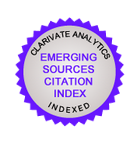Quantum-chemical study of the stability of solvents with respect to strong organic bases
https://doi.org/10.29235/1561-8323-2023-67-5-380-387
Abstract
The possibility of theoretical calculation of the ionization constants of strong organic bases in dimethyl sulfoxide and hexametapole was studied by the DLPNO-CCSD (T) and DFT methods. By comparison with the experimental data available in the literature, it has been established that the error of such calculations lies within 1–2 pKa units. The stability of some ionizing solvents against strong organic bases is investigated, the mechanisms of decomposition of solvent molecules in strongly basic media are predicted, and the corresponding energy barriers are estimated. According to the calculations, among ionizing solvents, hexamethylphosphoramide has the highest resistance to superbases, being able to maintain pH > 50 at room temperature. At the same time, 1,3-dimethyl-2-imidazolidinone gradually decomposes under these conditions, while tetrahydrofuran and pivalonitrile are even less stable.
About the Authors
A. V. KulshaBelarus
Andrey V. Kulsha, Senior Lecturer
220006
14, Leningradskaya Str.
Minsk
O. A. Ivashkevich
Belarus
Oleg A. Ivashkevich, Academician, D. Sc. (Chemistry), Chief Researcher
220006
14, Leningradskaya Str.
Minsk
References
1. Ishikawa Ts., ed. Superbases for Organic Synthesis: Guanidines, Amidines, Phosphazenes and Related Organocatalysts. John Wiley & Sons, 2009. doi: 10.1002/9780470740859
2. Puleo T. R., Sujansky S. J., Wright S. E., Bandar J. S. Organic Superbases in Recent Synthetic Methodology Research. Chemistry – A European Journal, 2021, vol. 27, no. 13, pp. 4216–4229. doi: 10.1002/chem.202003580
3. Schwesinger R., Schlemper H., Hasenfratz C., Willaredt J., Dambacher T., Breuer T., Ottaway C. [et al.] Extremely Strong, Uncharged Auxiliary Bases, Monomeric and Polymer-Supported Polyaminophosphazenes (P2–P5). Liebigs Annalen, 1996, vol. 1996, no. 7, pp. 1055–1081. doi: 10.1002/jlac.199619960705
4. Caubère P. Unimetal Super Bases. Chemical Reviews, 1993, vol. 93, no. 6, pp. 2317–2334. doi: 10.1021/cr00022a012
5. Tshepelevitsh S., Kütt A., Lõkov M., Kaljurand I., Saame J., Heering A., Plieger P. G., Vianello R., Leito I. On the Basicity of Organic Bases in Different Media. European Journal of Organic Chemistry, 2019, vol. 2019, no. 40, pp. 6735–6748. doi: 10.1002/ejoc.201900956
6. Lõkov M., Tshepelevitsh S., Heering A., Plieger P. G., Vianello R., Leito I. On the Basicity of Conjugated Nitrogen Heterocycles in Different Media. European Journal of Organic Chemistry, 2017, vol. 2017, no. 30, pp. 4475–4489. doi: 10.1002/ejoc.201700749
7. Rossini E., Bochevarov A. D., Knapp E. W. Empirical Conversion of pKa Values between Different Solvents and Interpretation of the Parameters: Application to Water, Acetonitrile, Dimethyl Sulfoxide, and Methanol. ACS Omega, 2018, vol. 3, no. 2, pp. 1653–1662. doi: 10.1021/acsomega.7b01895
8. Glasovac Z., Eckert-Maksić M., Maksić Z. B. Basicity of organic bases and superbases in acetonitrile by the polarized continuum model and DFT calculations. New Journal of Chemistry, 2009, vol. 33, no. 3, pp. 588–597. doi: 10.1039/b814812k
9. Schwesinger R. Starke ungeladene Stickstoffbasen. Nachrichten aus Chemie, Technik und Laboratorium, 1990, vol. 38, no. 10, pp. 1214–1226. doi: 10.1002/nadc.19900381005
10. Matulis V. E., Halauko Y. S., Ivashkevich O. A., Gaponik P. N. CH acidity of five-membered nitrogen-containing heterocycles: DFT investigation. Journal of Molecular Structure: THEOCHEM, 2009, vol. 909, no. 1–3, pp. 19–24. doi: 10.1016/j.theochem.2009.05.024
11. Kulsha A. V., Ragoyja E. G., Ivashkevich O. A. Strong Bases Design: Predicted Limits of Basicity. Journal of Physical Chemistry A, 2022, vol. 126, no. 23, pp. 3642–3652. doi: 10.1021/acs.jpca.2c00521
12. Tomaník L., Muchová E., Slavíček P. Solvation energies of ions with ensemble cluster-continuum approach. Physical Chemistry Chemical Physics, 2020, vol. 22, no. 39, pp. 22357–22368. doi: 10.1039/d0cp02768e
13. Reed C. A. Myths about the Proton. The Nature of H+ in Condensed Media. Accounts of Chemical Research, 2013, vol. 46, no. 11, pp. 2567–2575. doi: 10.1021/ar400064q
14. Neese F. Software update: the ORCA program system, version 4.0. WIREs Computational Molecular Science, 2018, vol. 8, no. 1, art. e1327. doi: 10.1002/wcms.1327
15. Crampton M. R., Rabbitt L. C. Kinetic and equilibrium studies of the ambident reactivity of aniline, and some derivatives, towards 4,6-dinitrobenzofuroxan. Journal of the Chemical Society, Perkin Transactions, 1999, vol. 2, no. 8, pp. 1669−1674. doi: 10.1039/a903123e
16. Kolthoff I. M., Chantooni Jr. M. K., Bhowmik S. Dissociation constants of uncharged and monovalent cation acids in dimethyl sulfoxide. Journal of the American Chemical Society, 1968, vol. 90, no. 1, pp. 23−28. doi: 10.1021/ja01003a005
17. Crampton M. R., Robotham I. A. Acidities of Some Substituted Ammonium Ions in Dimethyl Sulfoxide. Journal of Chemical Research, 1997, no. 1, pp. 22−23. doi: 10.1039/a606020j
18. Benoit R. L., Boulet D., Séguin L., Fréchette M. Protonation of purines and related compounds in dimethylsulfoxideand water. Canadian Journal of Chemistry, 1985, vol. 63, no. 6, pp. 1228−1232. doi: 10.1139/v85-209
19. Mucci A., Domain R., Benoit R. L. Solvent effect on the protonation of some alkylamines. Canadian Journal of Chemistry, 1980, vol. 58, no. 9, pp. 953−958. doi: 10.1139/v80-151
20. Simm N. G., Türtscher P. L., Reiher M. Systematic microsolvation approach with a cluster-continuum scheme and conformational sampling. Journal of Computational Chemistry, 2020, vol. 41, no. 12, pp. 1144−1155. doi: 10.1002/jcc.26161
21. Kulsha A. V., Ragoyja E. G., Ivashkevich O. A. Molecular Superbases Design. Sviridovskie chteniya [Sviridov Readings]. Minsk, 2022, vol. 18, pp. 97−108 (in Russian).














































